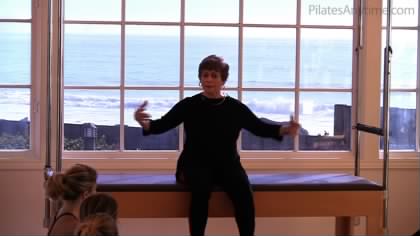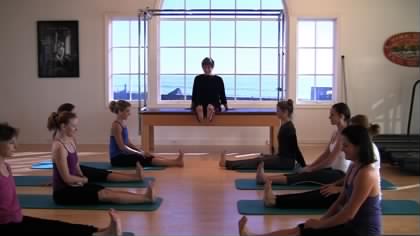Description
Lolita shares classic footwork that she learned from Joseph and Clara Pilates.
About This Video
Transcript
Read Full Transcript
Now. Let's talk about the feet. Let's do a ankle circle. It's really the whole leg that works, but we call it ankle circle. Into each other, up to the ceiling, all the way out, and around.
In, up, all the way out, and around. In, up, all the way out, and around. All the way in, all the way up, all the way out, and around. Let's reverse that circle. Out, up, all the way in, and around.
Out, up, in, and around. Out, up, in, and around. Out, up, in, in, in, in, in, and around. Legs together. And point.
And flex. And point. And flex. When we were standing, we all agreed that a dorsiflexion, or a standing-- which is what this is, right?-- went from big toe to little toe to heel, right? I ask you to point.
And then I ask you to flex. Would you give me that? That brings my little toe in front of my big toe. If I have my little toe in front of my big toe, if I stand up, where am I standing? I am supinating, right?
So it is of the utmost importance, when you do a dorsiflexion, that that dorsiflexion have perfectly the energy going out. Big toe, little toe, and heel. All on the same line. Big toe, little toe, and heel. All on the same line.
That's better. Now. Point again. Point. All right.
Now, here I have a case of pointing, in which the toes are curling under. And what I would like-- and what the Pilates foot is-- is not a foot that curls the toes under. And it's not a foot that has all that tension that a ballet foot has. It is a much more relaxed foot, in which your toes reach, rather than curl under. If you were to stand and point like that, you would be knuckling right down into your toe shoe.
So lengthen your toes when you point them. Point your feet. And I don't want you using flip-flops, madam. Those toes are curling in fast. You don't want them.
Hammer toes are a very painful operation. And point. And flex. And point. You know, when you're young, the body puts up with a lot of abuse, but it shows up later.
You pay your dues. Now, only press the arch down. Let the toes lengthen. Lengthen. Point them, but lengthening them.
Right. Bring the toes only, back. That means you're back on your very high heel, on the top of your metatarsal. Now give me a complete flex, with the energy leaving out of the heel. Right.
Sickled. And arch down. Toes follow through. Toes point. Toes back.
Foot back. Don't open. Just go straight back. And. Arch down.
Toes lengthen. Toes back. Foot back. I don't want them to touch. I don't want them to come into each other.
Each one has its own road. I don't want kissing toes. Arch down. Right. Toes point.
Right. On its own road. Toes back. And foot flexes. Good.
Now. Let's isolate our toes. Forward. And back. And forward.
And back. And forward. And back. And forward. OK, but forward is not sickled forward.
Forward has that little toe back. Right? And back. Back, back, back. Right.
Back toe still hasn't come back, Kristi. No. Still hasn't come back. No. That's back.
That's a flexed foot. Whoops. Now. Relax. Once we've done toes forward and back, we're going to fan our toes out.
And relax. Fan our toes out. And relax. And fan our toes out. No, don't-- why do you have your arch down?
Keep your foot flexed. Fan your toes out. And all the toes should go out on the same line. One little one shouldn't go around the corner. It has nothing to do around the corner.
It should go straight out. Right? And relax. And fan the toes out. And relax.
Now, you are thinking, why all this fuss over feet? Well, I firmly believe that that's where it all starts. That's where your posture starts. We're bipeds, no? We wonder sometimes, but yes, we are bipeds.
And, we have to be aware of our weight. On those two feet. And how we are using that weight. So therefore-- and anything that is slightly off, in those feet, is going to reflect itself right up the leg. Right?
You will have hip troubles, you will have spine problems-- you will have all kinds of problems. If, down there, you are not aligned-- OK. Now, as a dancer, I love feet. Yes. We all have a thing about feet.
But it wasn't only I. What I am giving you is Joe Pilates. Right? We point it. Pilates foot. We flexed.
He made sure that we were not sickling. He didn't call it sickling. But he'd go like that to that toe if it was front. Right? And, best of all, he created things, specially for the feet.
Right? Look at this. This is an arch corrector. This is to strengthen your arch. It's easy enough to put in arch support in your shoe, or an orthotics.
It does nothing for your foot. Yes, it will help to align you while you work, but to strengthen your foot, it will not do anything. Right? So, we have exercises. We have this gadget which you can press the foot flat down.
You can press the heel. You can press the toes. You can take the toes around like a bird on a branch. And, you can just press down, and up. And you can articulate your foot in many ways on that arch corrector.
All for the purpose of strengthening your foot and your arch. Right? And, you can see, has a spring. That was created by Joseph. And now, then, this.
Joe's gizmo being called lately. Joe's toe stretcher. And, you use it with a flexed foot. And you pull from it, and it is a wonderful thing for the bunions. And for the articulation, and of course, then you relax.
In everything we do, there must be tension and relaxation. Not just tension. And you open again. And you pull, and you pull, and you hold, and you hold, and you hold. And then, you relax.
How much time do you spend watching television? You can be sitting watching any program you want, and be doing your feet. And relax. And that'll pay off. Hey.
You can save yourself $100. And get a rubber band. And you can accomplish the same thing by using a rubber band. But while we get the rubber band, I want to show you another arch movement for the foot. Which is an arch contraction, in which you lift the arch from the mat, or the floor.
Without curling the toes, you place your fingers on those toes to make sure they don't curl. And you relax. And again, you contract that arch. And you relax. And you bring the toes towards the heel.
Lifting, lifting that arch from the floor. Right. And you can check and see if you can see the other side of the room. And relax. And contract.
And relax. And now grip the toes in, flex the toes back, and relax. Grip the toes in, flex the toes back, and relax. And grip the toes in, flex the toes back, and relax. On the other foot, arch contraction.
Toes towards heel. Long toes-- they do not curl. Lift that arch from the floor. And relax. And lift the arch from the floor.
Relax. Shorten the foot, lifting the arch, and relax. And shorten the foot, lifting the arch. And relax. And grip the toes in.
Pull the entire metatarsal back. Don't leave one toe out. And down. And in and back. And down.
And in and back. And down. And in and back. And down. So now.
Oh, we got the rubber band? Alright, I'll show you how to save money by using the rubber band. You make a figure eight, and you put it around one toe, and around the other toe. All right? And then I pull out.
And I relax. And I pull out. Out, out, out, out. And I relax. Saved you $100.
Pilates Legacy Project: Lolita San Miguel Methods
Comments
I actually found Pilates because of a foot problem. Still working on both. Thanks
You need to be a subscriber to post a comment.
Please Log In or Create an Account to start your free trial.






















